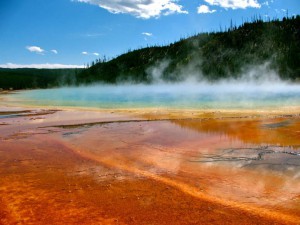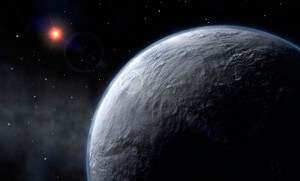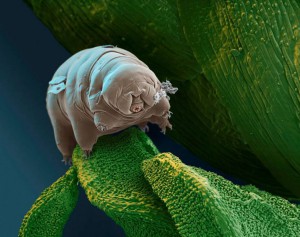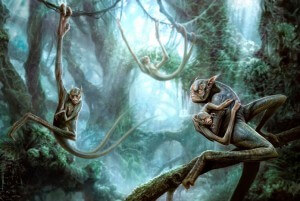
Exoplanets - the distant relatives of the Earth
 25. 06. 2018
25. 06. 2018

Look at the black night sky dotted with stars, they all contain wonderful worlds, similar to our solar system, are there planet-type planets in them? According to very modest calculations, the Milky Way galaxy includes more than hundreds of billions of planets, some of which may be Earth-like.
New information about "alien" planets, the exoplanets, has brought Kepler's space telescope, which examines the constellation and tries to capture the moments when the planet finds itself in front of its "sun".
The orbital observatory was launched in May 2009 to search for exoplanets, but failed four years later. Many attempts at commissioning followed, and eventually NASA was forced to write off the observatory from its "space fleet." However, during operation, "Kepler" has gathered so much unique information that it will take several more years to explore it. And NASA is already preparing to launch the successor to "Kepler", the TESS telescope, in 2017.
Superland in the Goldilocks belt
So far, astronomers have found nearly 600 new worlds out of 3500 candidates for exoplanet designation. They believe that there may be at least 90% of these cosmic objects that can prove to be "real planets," and the rest are binary stars that have not yet reached stellar proportions, "brown dwarfs," and clusters of large asteroids.
Most of the planet's candidates are giant giants like Jupiter or Saturn, as well as supermasses - stony planets that are several times larger than our planet. Clearly, the planets of the "Kepler" and other telescopes are far from being reached. The number of captured estimates is only for 1 - 10%.
In order for a truly exoplanet to appear, it must be targeted several times as it passes over the disk of its star. Such a planet must orbit near the star, so that its year is only a few days or weeks, and thus astronomers have the opportunity to repeat the observations several times. These planets in the form of hot gas spheres are often "hot Jupiters," and every sixth looks like a flaming superland covered in a sea of lava.
"Neither too much, nor too little"
In such conditions, the protein life of our species cannot exist, but there are exceptions among the hundreds of inhospitable circulars. So far, more than a hundred Earth-like planets have been found in the so-called habitable zone, otherwise known as the Goldilocks Belt.
This fairy-tale creature followed the principle of "neither too much nor too little." And so it is with the exceptional planets that are in the "zone of life" - the temperature must be within the range that allows the existence of water in a liquid state. At the same time, 24 planets out of more than a hundred have a radius smaller than two radii of the Earth.
And only one of these planets, which has the main characteristics of the Earth's twin, is located in the Goldilocks zone, has similar dimensions and belongs to the system of the yellow dwarf, to which our Sun also belongs.
In the world of red dwarves
Astrobiologists, diligently searching for extraterrestrial life, do not lose heart. Most of the stars in our galaxy are small, cold and dull red dwarfs. To the best of our knowledge, they are the red dwarves are roughly two times smaller and colder than the sun and make up at least three quarters of the "star population" of the Milky Way.
Around these "sun cousins" orbits miniature orthotics of Mercury, and there are Belly Bands.
Astrophysicists at the University of California, Berkeley, have even written a special computer program, TERRA, to help search for Earth's doubles. All orbits belong to the life zones of their little red stars. All this significantly increases the prospects for the presence of extraterrestrial cradles of life in our galaxy.
Dwarves are more active than the Sun
Previously, they thought that the red dwarfs, in which Earth-like planets were discovered, were calm stars, on the surface of which explosions were rarely accompanied by outbursts of plasma. But as it turns out, similar stars are far more active than the Sun. Cataclysms are constantly occurring on their surface, causing strong gusts of "stellar wind" capable of overcoming even the Earth's very strong magnetic shield.
Many earthly doubles can pay a fairly high price for a short distance from their star. Streams of radiation from individual explosions on the surface of red dwarfs can literally "lick" part of the planet's atmosphere, making these worlds uninhabitable. Consequently, the risk of coronal eruption increases because the weakened atmosphere cannot fully protect the surface from charged particles of ultraviolet and X-ray "stellar wind".
In addition, there is a danger of suppressing the magnetosphere of potentially habitable planets with a stronger magnetic field of red dwarfs.
Broken magnetic shield
Astronomers have long suspected that many red dwarfs have a very strong magnetic field that can easily pierce the magnetic shield of surrounding, potentially habitable planets. To do this, they created an entire virtual world, where our planet orbits a similar star in near orbit and is in a habitable zone.
 It turned out that the magnetic field of the dwarf not only very often deforms the Earth's magnetosphere, but even drives it below the planet's surface. Under such a scenario, neither air nor water would remain on the planet in a few million years, and the entire surface would be burned by cosmic radiation. This leads to two interesting conclusions: the search for life in red dwarf systems can be truly fruitless, and it could also be the reason for the "silence of the universe."
It turned out that the magnetic field of the dwarf not only very often deforms the Earth's magnetosphere, but even drives it below the planet's surface. Under such a scenario, neither air nor water would remain on the planet in a few million years, and the entire surface would be burned by cosmic radiation. This leads to two interesting conclusions: the search for life in red dwarf systems can be truly fruitless, and it could also be the reason for the "silence of the universe."
But it is possible that we can not find extraterrestrial intelligence because our planet was born too soon ...
The sad destiny of the first-born
After analyzing the data obtained with the Kepler and Hubble telescopes, astronomers found that the process of star formation in the Milky Way slowed significantly. This is related to the increase in the deficit of building materials in the form of dust and gas clouds.
However, there is still enough matter left in our galaxy for the birth of new stars and planetary systems, and moreover, in a few billion years, our star island will collide with the Great Galaxy in Andromeda, leading to a huge explosion of new stars.
Against the background of future galactic developments, a sensational report has recently emerged that four tenths of a year ago, at the time of the formation of the solar system, there were only a tenth of potentially habitable planets.
Considering that it took several hundred billion years to create the simplest organisms on our planet and then several billion more to create advanced life forms, then it is very likely that intelligent aliens will not appear until our Sun is extinguished.
Perhaps this is the solution to Fermi's paradox, which once was formulated by an excellent physicist: where are all those aliens? Or could we find the answers on our planet?
Extremophiles on Earth and in Space
The more we are convinced of the uniqueness of our space in the universe, the more often we come across the question of whether there can be and develop life in worlds that are quite different from ours, from Earth.
The answer to this question may be the existence of surprising organisms on our planet, extremophiles. They earned their name for their ability to survive in extreme temperatures, toxic environments and even without air. Marine biologists have found such organisms in underwater geysers, black smokers.
They thrive in those places, with enormous pressure, the absence of oxygen and at the very edge of the hot volcanic esophagus. Their "colleagues" can be found in salt mountain lakes, in hot deserts and under ice sheets in Antarctica. There are even organisms, tortoises (Tardigrada), that are able to survive in a vacuum in space. As a result, even in the radiation belts of red dwarfs, some extreme microorganisms can form.
Theory of Life on Earth
Academic evolutionary biology assumes that life on Earth arose from chemical reactions in the "warm and shallow sea," whipped by currents of ultraviolet radiation and ozone from "lightning storms." From another point of view, astrobiologists know that the chemical "bricks" of the foundations of life are also on other planets. They have been found, for example, in dust-gas nebulae and in the systems of our gas giants. It is not yet a "full life", but it is already the first step towards it.
The "official" theory of life on Earth has been recently hit by a powerful blow from geologists. The first organisms turned out to be much older than previously thought, and formed in a completely unfavorable environment of a methane atmosphere and a bubbling magma spilling from a thousand volcanoes.
Many biologists have been forced to reflect on the older theory of panspermia. According to her, the first microorganisms originated elsewhere, say on Mars, and reached Earth in meteorite nuclei. It is possible that ancient bacteria had to undergo an even longer journey in comets from other constellations.
But if that were indeed the case, then the paths of "cosmic evolution" could lead us to "our native brothers," whose origins come from the same "seed of life," the same source as ours. "





 6
6


